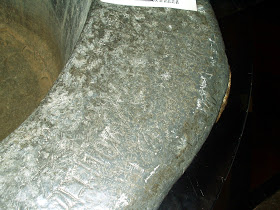This curious building at WHEATLEY on the outskirts of Oxford was the old village lock-up
dating to 1834.
The magnificent Baroque masterpiece of Blenheim Palace
is situated at WOODSTOCK to the north of Oxford. Designed by Sir Nicholas Hawksmoor and Sir John Vanburgh the palace was a gift from the nation following the defeat of the French at the Battle of Blenheim in 1704 by John Churchill, the 1st Duke of Marlborough.
It was also the birthplace of Sir Winston Churchill in 1874.
BURFORD in the extreme west of the county, is a charming little Cotswold
town on the River Windrush which is bridged at the bottom of the
long sloping High Street.
A poignant signature scratched on the lead lining of the font in Burford Parish Church recalls an incident of mutiny within Cromwell’s New Model Army. It reads :
‘ANTHONY SEDLEY
1649. PRISNER’
He was one of the supporters of The Levellers, a group of radicals who were crushed by Cromwell. On May Day 1649 the army had reached Salisbury on
‘ANTHONY SEDLEY
1649. PRISNER’
He was one of the supporters of The Levellers, a group of radicals who were crushed by Cromwell. On May Day 1649 the army had reached Salisbury on
its way to Ireland when eight soldiers refused to go any further until their complaints were satisfied. They wanted a levelling of the ranks within the army and an end to Cromwell's campaign in Ireland, as well as the considerable back pay owed to them. Several hundred troops ended up deserting, eventually meeting up with comrades in Banbury. The upshot was that they were defeated by loyal troops and imprisoned in Burford Church, the only building big enough to contain them. Three lof their leaders were court martialled on the spot
and sentenced to death.On the morning of 17th May the majority were taken up onto the church roof so that they could watch whilst Cornet Thompson, Corporal Church and Private Perkins were put against the church wall and shot.
Edmund Harman had a large family, nine boys and seven girls, and their images are carved on his fine memorial in Burford Parish Church
‘EDMUND HARMAN Esq.
Whom God from his earliest years blessed with countless benefits,
Put this monument to the Christian memory of himself
and of his only and most faithful wife AGNES
and of the 16 children whom, by God’s mercy, she bore him.
1569’
As barber and personal servant to King Henry V111 he was trusted to hold a razor to the King’s throat and once when he was ill with no doctor available, Harman successfully ‘bled’ the King. Harman was also a witness to the King’s will, a close servant indeed. Figures of Red Indians and strange fruits also adorn the monument which are thought to commemorate discoveries made by Harman’s brother on voyages abroad.
BANBURY in the north of the county is a former woollen town which dates back to Saxon times.
The Oxford Canal which was once important to the economy of the town is now given over to leisure activities
The town is perhaps best known for the nursery rhyme, Ride a Cock Horse to Banbury Cross.
The original Banbury Cross was destroyed by the Puritans in 1600. The present cross, 16 metres high, was erected in 1859 to commemorate the marriage of Queen Victoria's daughter
Princess Victoria.
The fine lady on the white horse may have been Lady Godiva or even Elizabeth 1, but more likely she was the local Queen of the May with the horse being a child's hobby horse. A nearby sculpture is by Denise Dutton.


.JPG)
.JPG)
.JPG)
.JPG)
.JPG)
.JPG)




.jpg)


.JPG)
.JPG)
.JPG)
.JPG)
.JPG)
.JPG)
.JPG)
.JPG)
.JPG)
.JPG)
.JPG)
No comments:
Post a Comment